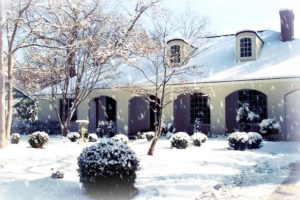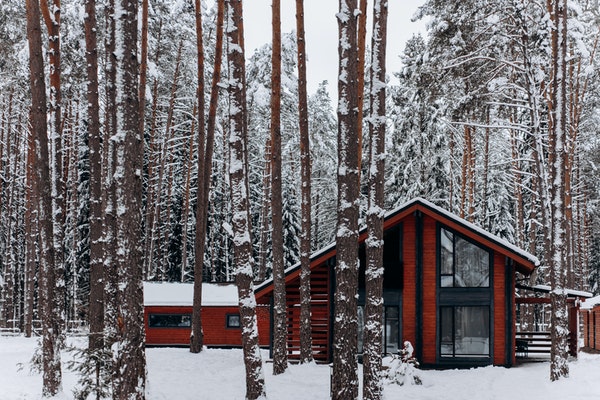Winterizing your home is not just a measure to increase comfort during the colder months. This is also a means to a more energy efficient home leading to savings on utilities in the longer run. Here are 10 tips to winterize your home so you can yield savings.

Find efficient ways to winterize your home with these tips.
10 Tips to Winterize Your Home
1. Seal Drafts
Drafts around windows and doors are common culprits for heat loss. Especially if you are living in an older house you will have this issue more than a newer build. Inspect these areas and use weatherstripping or caulk to seal any gaps. For an additional layer of insulation, consider using draft stoppers at the bottoms of doors. Sealing power not commonly used power outlets is an additional step in this process. This simple step can prevent cold air from sneaking in and warm air from escaping, ultimately reducing your heating costs.
2. Insulate Your Attic
Heat naturally rises, and if your attic isn’t properly insulated, this heat can easily escape, leading to higher energy bills. Adding extra insulation to your attic can help maintain a consistent temperature throughout your home It’s also a good idea to insulate attic access doors or hatches as well.
3. Service Your Heating System
An efficient heating system is required for winter comfort and the health of your heating costs. Schedule a professional service for your furnace or heating system before winter sets in. Regular maintenance ensures it’s running efficiently. This way you can identify potential issues early, and prevent unexpected breakdowns in the depths of winter.
4. Reverse Ceiling Fans
Many people don’t realize that ceiling fans can be used year-round. By setting your fans to run in a clockwise direction during winter, they push warm air down from the ceiling (without creating a breeze). This can allow you to lower your thermostat setting, saving money on heating costs.
5. Programmable Thermostat
A programmable thermostat is a wise investment for energy efficient homes. By setting it to lower the temperature when you’re asleep or away, you can significantly reduce your heating bill. Modern smart thermostats offer even more convenience, with features like learning your schedule and adjusting temperatures based on your habits. However, remember that you have to maintain a certain temperature in your home through out winter to avoid pipes from freezing. Never turn off your heat even when you are away for longer periods of time.
6. Insulate Pipes
Frozen pipes are not just an inconvenience; they can burst and cause significant damage. Insulate your water pipes, particularly those in unheated areas like basements, garages, and under kitchen and bathroom cabinets. This also helps hot water pipes retain their heat better, reducing energy costs. If you have sprinkler systems running outdoors make sure they are properly winterized to avoid any freezing of pipes. Ideally this should be done prior to the first frost of the season.
7. Clear Gutters
Gutters clogged with leaves and debris can lead to ice dams, which prevent proper drainage and can cause water to seep into your home. Cleaning your gutters in the fall is a preventative measure that protects your roof and interior walls from water damage.
8. Use Thick Curtains
Thick curtains or drapes add an extra layer of insulation to your windows. Open them during sunny days to let in natural warmth and close them at night to keep the heat in. This is a simple, cost effective method to enhance your home’s ability to retain heat.
9. Check Your Roof
A well-maintained roof is vital for winter weather resilience. Inspect your roof for any signs of damage like missing or loose shingles and have them repaired promptly. This helps prevent water damage from snow and ice melting and refreezing. If you are in heavy snow prone areas make sure you clean your roof after a snow storm as much as you would a drive-way. Accumulated snow piles on roofs can lead to damages to the roof or even ice dams.
10. Mind Your Chimney
If you have a wood-burning fireplace, ensure your chimney is clean and the damper closes properly when not in use. An open damper is like an open window, allowing warm air to escape. Additionally, consider a chimney balloon to block drafts when the fireplace is not in use.
What Are Some Additional Tips to Winterize Your Home?
- Interior Maintenance: Check that your smoke and carbon monoxide detectors are working properly. Winter sees an increase in indoor heating and cooking, which can elevate risks.
- Exterior Preparations: Trim any tree branches that could break under the weight of snow and ice and damage your home or power lines.
- Emergency Kit: Have an emergency kit ready with supplies like bottled water, non-perishable food, flashlights, and blankets in case of power outages.
- Heating Vents and Radiators: Make sure they are not blocked by furniture or drapes for efficient heat distribution.
- Install Storm Doors and Windows: These provide an extra layer of protection and insulation, especially for older homes.
- Use Area Rugs: They add a layer of insulation to your floors, especially if you have hardwood or tile flooring, and can make walking around the house more comfortable.
- Humidify Your Home: Dry winter air can make your home feel cooler and lead to respiratory issues. A humidifier can make your living space more comfortable.
Bottom Line…
Winterizing your home requires some effort and investment, but the benefits are significant. Not only does it enhance the comfort of your living space, but it also contributes to substantial savings on energy bills. By implementing these steps, you can enjoy a cozy, warm, and efficient home throughout the winter season.
If you’re struggling to pay off debt, ACCC can help. Schedule a free credit counseling session with us today.





